Article
Bunker Hill Lodge
"A little bit of Athens on the Bunker Hill Monument Grounds is the pleasing picture presented by the new lodge of solid masonry and artistic Grecian columns which is now completed."
—from the Charlestown Enterprise, September 6, 1902
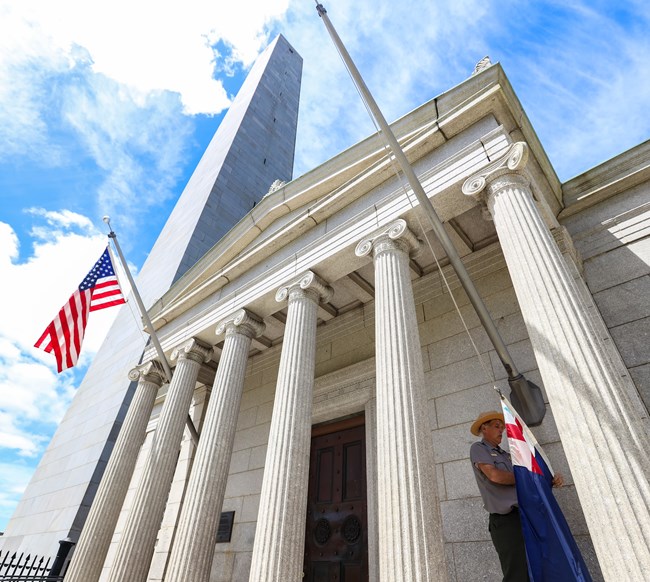
NPS Photo Matthew Dwyer
If you visit Breed's Hill in Charlestown, Massachusetts, you'll see two buildings that resemble ancient forms: an Egyptian obelisk and a Greek temple. The obelisk is the Bunker Hill Monument. Completed in 1843, this monument was the first large obelisk built in the United States. Beside it stands the Bunker Hill Lodge, which opened in 1902. This structure resembles a Greek temple both inside and out. Antiquity architecture inspired the designs of many buildings constructed during the early years of the new country. Americans particularly liked the Greek Revival style; this style influenced the construction of the U.S. capitol building, which began in 1793.
Staff of the National Parks of Boston, part of the National Park Service (NPS), operates the Bunker Hill Monument and Lodge. The NPS is the third caretaker of this complex, whose history dates to 180 years ago. The Bunker Hill Monument Association (BHMA), a patriotic citizens group, and the Commonwealth of Massachusetts have also served as caretakers.
The BHMA built the obelisk as a memorial to the Battle of Bunker Hill and to the Provincial militia that fought in the battle. They also built the obelisk as a tourist attraction. The BHMA asked the monument's architect, Solomon Willard, to build an internal, spiral granite staircase from the bottom to the top of the monument. At the top of the monument, they also requested four windows, which provided a panoramic view of the surrounding area. Upon the completion of the Monument, the BHMA planned to charge visitors a fee to ascend the 294 stairs.
A Gateway
To collect the fee, the BHMA had to control access to the Monument. They decided to surround the Monument with a fence and construct a gateway building. Such a building is known as a lodge, a small building that controls access to a larger building or property. Although a "lodge" can also be a meeting place for a fraternal organization, the BHMA used the former definition.
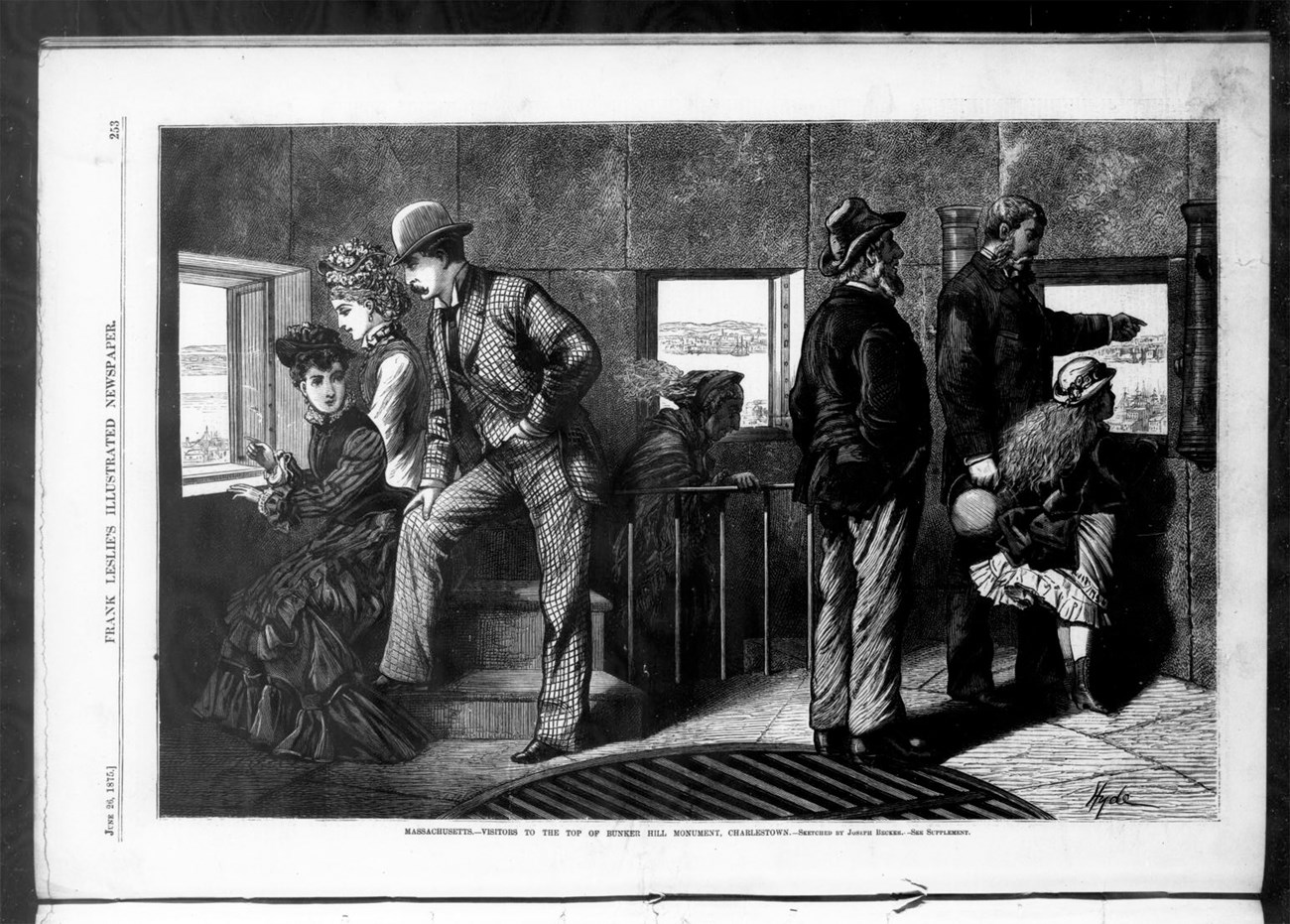
"Massachusetts - Visitors To The Top of Bunker Hill Monument. Charlestown. - Sketched by Joseph Becker - See Supplement." Frank Leslie’s Illustrated Newspaper June 26, 1875. Internet Archive.
When the Bunker Hill Monument opened in 1843, the BHMA intended to have a granite lodge built alongside it. However, the construction of the monument had exhausted the organization of all its resources. The BHMA could only afford a fence and a small shed to control access to the monument.
In the meantime, the BHMA collected climbing fees, which they used to pay a small staff to maintain the monument. They also used these fees to begin raising money to build the lodge. The Bunker Hill Monument instantly became a popular attraction. As many as 20,000 people climbed the stairs of the monument yearly. Each climber paid 12 ½ cents to climb, generating about $2,500, or $88,000 today.
A View for Sale
In 1848, responding to public demand, the BHMA commissioned a booklet titled "The Panoramic View from Bunker Hill Monument." It had a fold-out drawing of the 360-degree view seen from the four windows at the top of the monument. It's a unique view of the bustling Boston-area from that era, "one of the finest in the world" according to the publisher.
Over the following years, the BHMA continued to promote the panoramic view from the top of the Monument. The organization wanted the public to experience the Monument as both a war memorial and as a tourist attraction. The Monument continues to serve this purpose today. Currently, the staff of the National Parks of Boston have also created a 360-degree view from the top of the Monument.
By 1850, the BHMA still wanted to build a granite lodge, but another project claimed its attention. One of the group's members, Colonel Thomas H. Perkins, offered $1000 to help build a statue of General Joseph Warren, who died in the Battle of Bunker Hill. Perkins pointed out that the 1775 Continental Congress had suggested a Warren statue to be placed at the battlefield, and it had offered to help pay for the statue.
A Place for Warren
The U.S. Congress in 1850 declined extending the same offer the Continental Congress had made to build a statue in honor of General Warren. If they wanted a statue, the members of the BHMA had to finance it. About 60 members donated another $4000 to the fund, and by 1855 the group had $5000. They commissioned local artist Henry Dexter to sculpt the statue. After two years, Dexter finished the seven-foot, Italian marble statue. It captures Warren displaying the stance and hand gesture of an orator for which he was renown. The Warren family donated a Vermont-quarried green marble base for the statue.
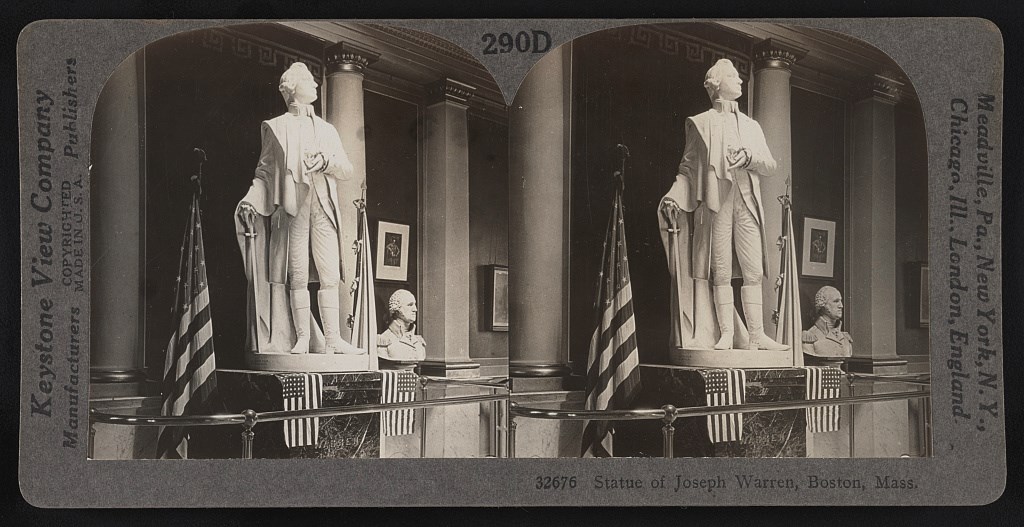
Library of Congress
During an outdoor ceremony in 1857, the BHMA unveiled the General Warren statue, which stood near the monument. Still without the funds necessary to build a granite lodge, the BHMA hired William Patterson to build a humble one-story, 28-foot square wooden lodge near the Monument. Patterson completed this construction in time to house the Warren statue.
While the lodge needed to serve as a gateway to the Monument, the BHMA intended it to have another, more meaningful purpose. They also wanted it to be a place for visitors to contemplate the story of the Battle and its aftermath. With the Warren statue as the main feature of the lodge, the BHMA also installed some "relics" to help tell the story of Bunker Hill. In the lodge, visitors could view a colonial musket (not from the battle), some cannon balls and the sword of General Israel Putnam who fought in the Battle. The BHMA also displayed portraits of battle notables and maps of the battlefield.
Due to financial challenges, the BHMA had to use the wooden lodge for the next 45 years. The Monument continued to be popular. Visitation grew from 20,000 to 30,000 climbers a year, although fewer people visited the Monument during the Civil War. The cost to climb increased to 20 cents, at least $3 today. Staff opened the Monument and lodge daily and year-round, except Christmas Day.
A Granite Lodge
In 1870 the BHMA finally set up a fund for the construction of the granite lodge; it would rely on visitors' fees and the generosity of hundreds of its members. By 1897, about sixty years later than originally planned, the BHMA had raised enough money to start the project.
The BHMA hired Arthur H. Vinal to design the granite lodge in the Greek Revival style. Vinal envisioned a one-story building slightly larger than the wooden one it would replace. The granite for the lodge came from Deer Isle, Maine, and it resembles the Monument's local Quincy granite. Vinal designed the lodge at a time when tourists expected a pampered experience. In the early 1900s, tourists wanted not only toilet facilities but also nicely decorated lounge rooms in which to freshen up. At a location where you might climb nearly 300 stairs, these rooms would be essential.
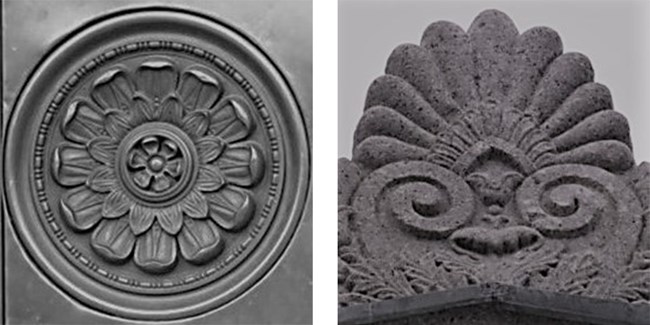
NPS Photo
In 1902 the Bunker Hill Lodge opened, the same Lodge that still stands today. Originally, visitors walked between the six granite ionic columns to enter the Lodge. Later, workers relocated the main entrance of the Lodge to the side of the building. In the shape of a rotunda, the lobby of the Lodge has a dome and skylight. When the Lodge first opened, visitors used the rooms on either side of the lobby as lounges, one for men and the other for women. These lounges have since been removed.
Beyond the lobby is the Statuary Room. This room encompasses the other half of the Lodge, and like the previous wooden lodge, this room features the Warren statue. The Statuary Room has numerous pilasters, or wall-mounted pillars and columns, with a domed ceiling and skylight.
Beautiful masonry and designs fill the Lodge. Architect Vinal used Greek Revival decorative trim, notably with palmette motifs, inside and outside the Lodge. Siena marble covers the walls of the lobby, while those of the former lounges have Carrera marble. Carrera marble partly covers the walls of the Statuary Room as well. Mosaic tiles cover the floors throughout the Lodge. The cost of the original installation of the Italian marble and tiles encompased nearly half the expense of building the Lodge.
A State Ward
The granite Lodge cost over $35,000 to construct, about $1.2 million today, and it nearly bankrupted the Bunker Hill Monument Association. In 1919, the BHMA transferred ownership of the Monument, Lodge, and grounds to the Commonwealth of Massachusetts.
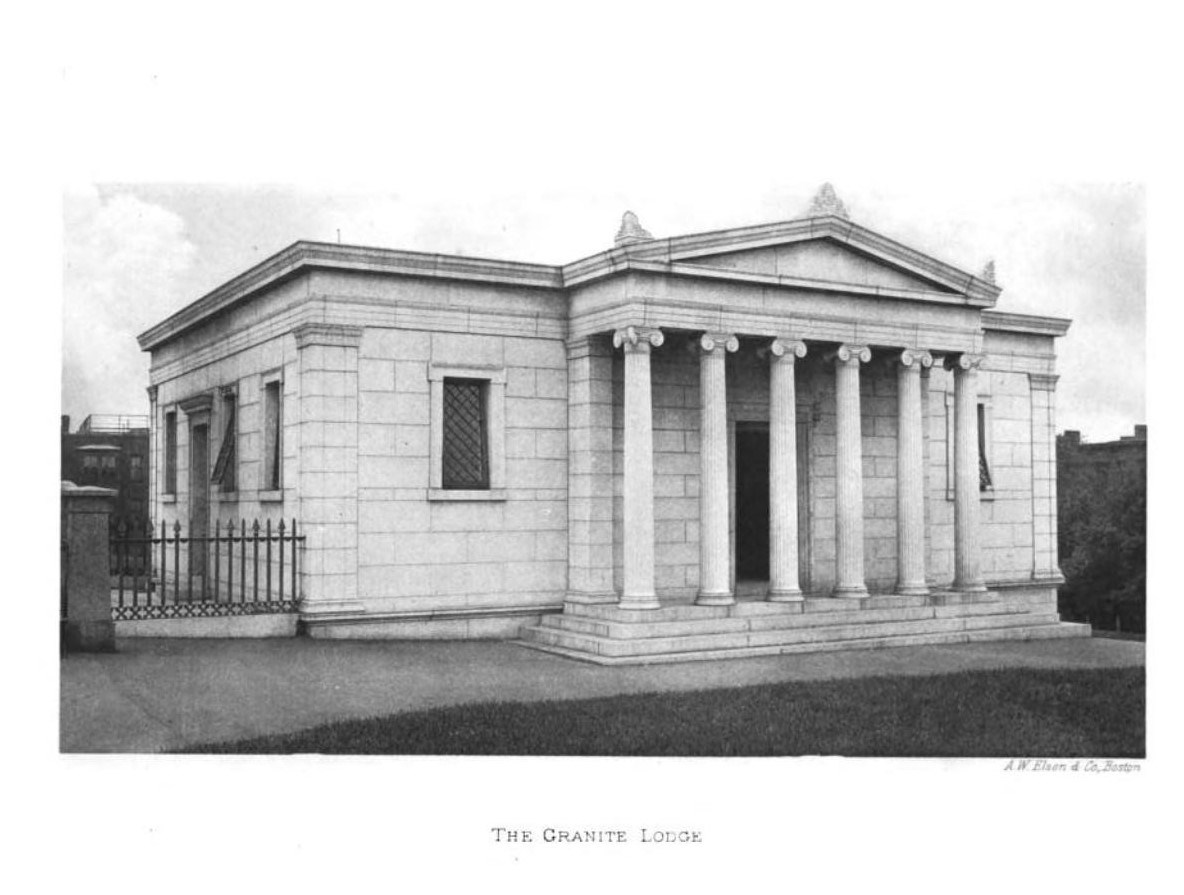
Bunker Hill Monument Association.
A state division called the Metropolitan District Commission (MDC) took care of the Bunker Hill Monument and Lodge. They primarily focused on preserving the physical structures and left historical interpretation of the site open to third parties. This decision brought a lot of changes to the Lodge.
In 1922, the Breed Family Association asked the MDC to install a plaque prominently on Breed's Hill to remind visitors that some of the Battle of Bunker Hill took place at this site. The MDC approved their request and installed the Breed's Hill plaque on the exterior of the Lodge. In 1959, the US Army Corps of Engineers asked the MDC if they could install a plaque in the lodge honoring Colonel Richard Gridley, known as the First Chief Engineer of the Corps. Gridley served a critical role during the Battle as he planned the colonial defenses at the Bunker Hill battle. The MDC approved the Gridley plaque in the lobby of the granite Lodge.
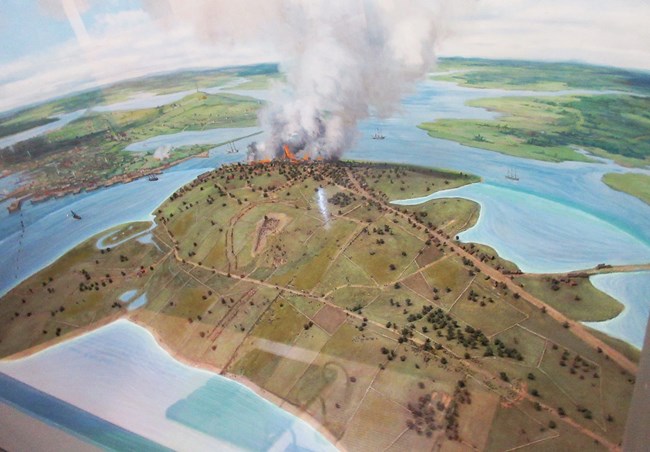
NPS Photo
The Battle in a Box
The MDC also accepted three dioramas for display in the Lodge. A diorama, or large model, is a popular way to present natural and historical scenes to the public. The MDC installed one of these dioramas in 1947. Theodore B. Pitman created a bird's-eye view of Charlestown during the Battle of Bunker Hill. The Military Collectors of New England, a team of sixty individuals, made the other two dioramas. One portrays the scene at the colonial breastworks and the other is a large tabletop diorama of the Battle. After being part of an American Revolutionary War Bicentennial exhibit at the Museum of Fine Arts in Boston, the sponsors of these two dioramas donated them to the MDC which installed them in the Statuary Room of the granite lodge in 1976.
The MDC managed the Battle of Bunker Hill site for nearly sixty years. It charged visitors a fee to climb the Monument and kept the Monument and Lodge open the same hours as the BHMA did. By 1975, the MDC had trouble maintaining the site, and it had also lost track of some exhibit items, such as the period musket and sword. The Commonwealth of Massachusetts asked the federal government to take over the complex.
A National Site
Today, the National Park Service (NPS) operates the Bunker Hill Monument and Lodge. The number of visitors to the Monument and Lodge increased over the years from 50,000 to beyond 250,000 a year. None of these visitors had to pay a fee to make this climb, and no fee is required today. Starting in 2006, the NPS made major changes to the Bunker Hill Lodge. Staff built a new entrance on the south side of the building to accommodate ramp access to the lodge. The NPS also changed some of the lodge's floor plan.
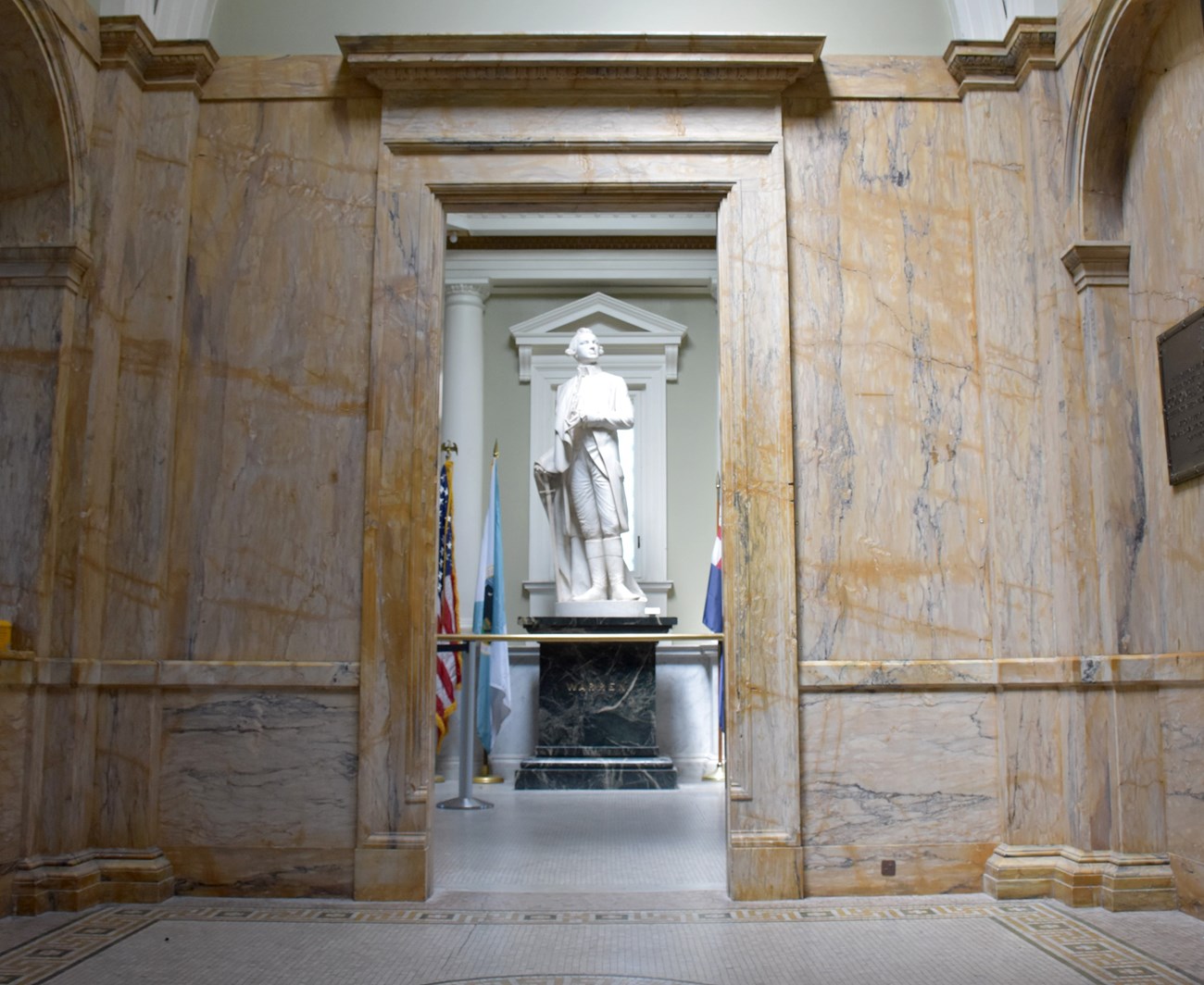
NPS Photo
Another big change to the Bunker Hill Lodge came in 2008 when the City of Boston vacated its Charlestown Public Library branch. Located on Monument Square, this building stands across the street from the Bunker Hill Monument. The city offered use of this building to the NPS. By transforming this library into the Bunker Hill Museum, the NPS was able to reconsider the use of the lodge. The Park Service transferred the three dioramas of the battle and other exhibit items out of the crowded Bunker Hill Lodge into the new Bunker Hill Museum.
The Statuary Room in the lodge still holds the Warren statue and a few exhibit panels related to the Bunker Hill Monument and the legacy of the battle. Like the BHMA and the MDC before them, the NPS found that the Bunker Hill Monument and Lodge require constant care and preservation.
If you visit the Bunker Hill Lodge today, it is possible to experience the building as the BHMA intended. It's a place of simple solemnity, echoing the formality of a Greek temple. While not a temple for the Greek gods, it honors early Americans who made sacrifices at the Battle of Bunker Hill for the benefit of all. However, don't expect the Bunker Hill Lodge to be a place of quiet contemplation on a nice summer weekend. On a busy day, hundreds of people pass through this building to climb the stairs of the monument. The Bunker Hill Lodge still performs the role that the BHMA intended nearly 180 years ago: a gateway to the Monument.
Sources
"A Model in Architecture." Charlestown Enterprise. September 6, 1902.
Bunker Hill Monument Association. Inauguration of the Statue of Warren, June 17, 1857. By the Authority of the Committee, Boston, MA, 1858.
"Fighting Bunker Hill Battle Again---with Ink." Boston Daily Globe. February 5, 1922, P 45.
Fripp, Bill. "The Tiny Grenadiers Mass for the Charge up Bunker Hill." Boston Globe. May 31, 1975, p.23.
Hardy-Heck-Moore, Inc., Volz & Associates, Inc. Historic Furnishings Report, Bunker Hill Granite Lodge, Part 1 and 2. Boston, MA: Northeast Museum Services Center, National Park Service, 2011.
"Lodge on the Hill," Charlestown Enterprise, June 29, 1901, p.1.
Siobahn, Mc Elduff, Unroman Roman, Oratory, Male Oratory and Dressing, Oratory – UnRoman Ro+mans (bccampus.ca) (accessed April 5, 2023).
Smillie, James, Mallory, R.P. A Panoramic View from Bunker Hill Monument. Boston, MA, Redding & Co. 1848. Panoramic view from Bunker Hill Monument - Norman B. Leventhal Map & Education Center, (Accessed April 6, 2023).
Stull Associates, Snell, Charles W., Evans, G. Rodger. Historic Structure Report, Bunker Hill Monument, 1818-1916, Historic Data and Architectural Data Sections, Vol 1. Denver CO, National Park Service, U. S. Dept. of the Interior, 1982.
Wilson, Henry. "Model of the Bunker Hill Battle," Boston Daily Globe, July 4, 1948, p.B3.
Last updated: January 12, 2026
